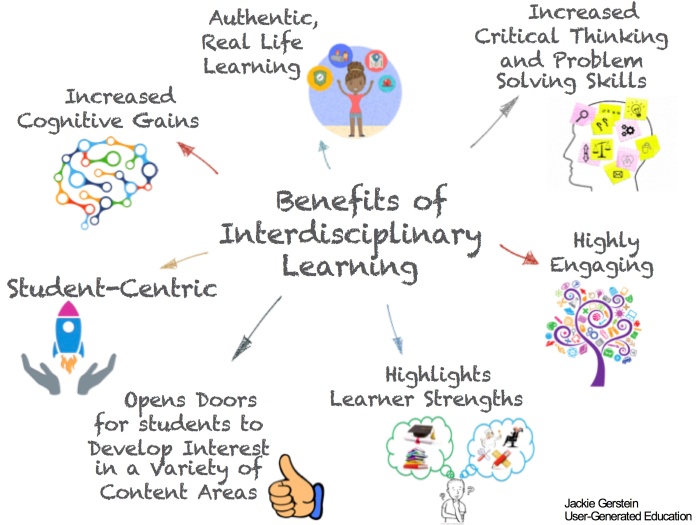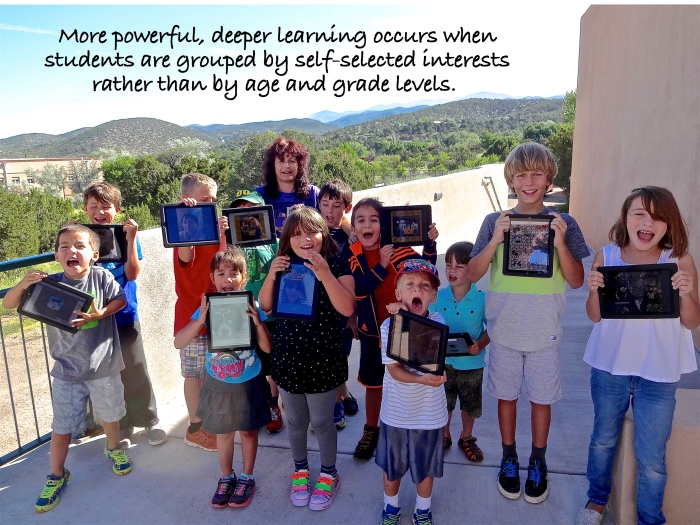Posts Tagged ‘interest-driven’
All Lessons Should Be Interdisciplinary
I am not a fan of worksheets. In fact, I hate most of them. They don’t teach real world skills. How often does someone do worksheets outside of school? How often when they become adults? They also tend to focus on a single content area concept like specific math problems or questions about a particular text.
I used to teach face-to-face elementary education classes to pre-service teachers. There is evidence that teachers teach the way they were taught. I know that almost everyone has been subjected to worksheets as part of their K-12 (even college) education. It follows, then, that theses new teachers will use worksheets as part of their teaching strategies. I can’t blame them especially if they are not intentionally taught and do not practice other instructional strategies as part of their education.
My instruction with them included a focus on interdisciplinary/cross-curricular, thematic, experiential, and project-based learning. I did very little sage on the stage with them during our classes as I wanted them to directly experience these strategies. They did lots of group discussion, case study analysis, and hands-on activities. I often said to them, “You really don’t have enough time in a day to adequately address all of the individual content areas. It is in both your and your students interest to layer your curriculum with a variety of content area concepts, ideas, and skills that can only occur with more project-based and interdisciplinary lessons. Worksheets won’t do this.”
Multidisciplinary or interdisciplinary learning is a “whole” or “comprehensive” method that covers an idea, topic, or text by integrating multiple knowledge domains. It is a very powerful method of teaching that crosses the boundaries of a discipline or curriculum in order to enhance the scope and depth of learning. Each discipline sheds light on the topic like the facets of a gem.
Imagine being able to teach character development, basic math, and basic science concepts via a classic text. How about basic geography, writing skills, and point of view from that same text? Is it possible to also teach about comprehension, sequence, literal vs. non-literal, imagination, plot, theme, compare and contrast, opinion pieces, vocabulary, friendship, bullying, and critical thinking? The answer is yes, and the genre is legends, myths, and fables (https://www.edutopia.org/blog/a-cornucopia-of-multidisciplinary-teaching-vincent-mastro).
Benefits of Interdisciplinary Learning:
- Obviously, it addresses multiple content areas resulting in increased cognitive development as deeper learning occurs.
- It mimics real life learning rather than isolated educational experiences. It is authentic. When we learn something in the real world, it is interdisciplinary. For example, when learning how to bake or cook something new, one often does research for the best recipes and cooking strategies, reading of recipes and directions, and using math in the actual cooking or baking.
- It helps students increase their critical thinking and problem solving skills. Due to the nature of interdisciplinary learning which often includes the characteristics of deep and project-based learning, students are asked to make their own connections and conclusions about their learning.
- It is student-centric. The focus is on the student rather than on the teacher and on lower levels of Bloom’s taxonomy that often occurs when students are given drill and grill learning activities.
- It tends to be highly engaging for students. They engage because interdisciplinary activities often have at least one content area that is of great interest to the student. It highlights their strengths.
- It opens doors for students to develop interest in content areas in which they have not been typically interested as they see connections between their desirable content areas and other ones.

Some of my blog posts about my interdisciplinary lessons:
- Gingerbread House Making: A Fun and Engaging Cross-Curricular Lesson https://usergeneratededucation.wordpress.com/2018/12/08/gingerbread-house-a-fun-and-engaging-cross-curricular-lesson/
- Day of the Dead (Dia de los Muertos) Displays: A Maker Education Project https://usergeneratededucation.wordpress.com/2018/11/06/day-of-the-dead-dia-de-los-muertos-displays-a-maker-education-project/
- Robot-Enhanced Creative Writing and Storytelling (featuring Ozobot and Wonder’s Dot) https://usergeneratededucation.wordpress.com/2018/05/15/robot-enhanced-creative-writing-and-storytelling-featuring-ozobot-and-wonders-dot/
- Elementary Social Entrepreneurship: A Perfect STEAM Lesson https://usergeneratededucation.wordpress.com/2018/05/13/elementary-social-entrepreneurship-a-perfect-steam-lesson/
Why do we group students by manufacture date?

Ken Robinson once famously said, “Students are educated in batches, according to age, as if the most important thing they have in common is their date of manufacture.” (Ken Robinson, The Element: How Finding Your Passion Changes Everything).
I have the privilege of working with 2nd through 6th graders in my gifted education classes and Kindergarten through 6th grade in my summer STEM and robotics camps. With my summer camps, they get to choose their camp by interest not age. In my gifted program, they select from a menu of content areas so it is also interest- rather than age-driven. I wouldn’t have it any way.
The Problem with Grouping Learners by Age
Grouping students by age or manufacture date is a contrived sorting mechanism. It assumes that same age kids are alike in their intellectual, physical, emotional, and social development; that they have commonalities in addition to their age. Academic standards used by almost all schools are based on the false and incorrect belief of the average student. Todd Rose quoting Mike Miller’s research on brains found that “not a single one was even remotely close to the average. The average represented nobody,” and he added, “Average is widely misleading. In education, there is no such thing as an average student. Our educational system is built on the assumption that there is an average student.”
This critique of age-grading was written in 1912 by Frederick Burk:
It is constructed upon the assumption that a group of minds can be marshaled and controlled in growth in exactly the same manner that a military officer marshals and directs the bodily movements of a company of soldiers. In solid, unbreakable phalanx the class is supposed to move through all the grades, keeping in locked step. This locked step is set by the ‘average’ pupil–an algebraic myth born of inanimate figures and an addled pedagogy. The class system does injury to the rapid and quick-thinking pupils, because these must shackle their stride to keep pace with the mythical average. But the class system does a greater injury to the large number who make slower progress than the rate of the mythical average pupil . . . They are foredoomed to failure before they begin.
In his article, The Science of the Individual (why average doesn’t make sense in school, A.J. Juliani quoted Rose:
This is not a new debate. In fact, this century-old clash of foundational assumptions might be regarded as the cardinal battle for the soul of modern education. On the side of education for individuality, we find some of the most admired and progressive names in American education, including John Dewey, Charles Eliot, and Benjamin Bloom. These “Individualists” were animated by their defining assumption that every student is different and that education should be designed to accommodate those differences.
Grouping by Interests Rather Than Age
I do understand that mixed age groups will have developmental differences but in my programs, they are grouped by interests rather than by age. I find this to be more natural and mimics real world learning as individuals often seek out others in their out-of-school lives who have similar interests. Interest-driven learning is much more motivating and engaging. Community develops naturally due to shared interests. With groups of same aged peers, there may be no connections other than age.
I find the advantages of multiage groups to be:
- Increased sense of community as learners bond through discussing and participating in interest-driven activities.
- Increased socialization skills as the kids learn to navigate the learning tasks in their multiage groups.
- More variety and perspectives. At times, even the youngest kids offer unique ideas of which the older kids hadn’t thought.
- Older kids helping the younger kids which leads to feelings of importance and responsibility.
- Decreased behavior problems as the kids become engaged in learning activities they would choose to do outside of school.
In addition, the Association for Childhood Education International (ACEI) lists the following benefits of multiage classrooms:
- Children are viewed as unique individuals. The teacher focuses on teaching each child according to his or her own strengths, unlike in same-grade classrooms that often expect all children to be at the same place at the same time with regard to ability.
- Children are not labeled according to their ability, and children learn at their own rate.
- Children develop a sense of family with their classmates. They become a “family of learners” who support and care for each other.
- Older children have the opportunity to serve as mentors and to take leadership roles.
- Children are more likely to cooperate than compete. The spirit of cooperation and caring makes it possible for children to help each other as individuals, not see each other as competitors.
- Older children model more sophisticated approaches to problem solving, and younger children are able to accomplish tasks they could not do without the assistance of older children. This dynamic increases the older child’s level of independence and competence.
- Children are invited to take charge of their learning, by making choices at centers and with project work. This sense of “ownership” and self-direction is the foundation for lifelong learning.
- Children are exposed to positive models for behavior and social skills. (http://www.uwyo.edu/ecec/_files/documents/multi-age-benefits.pdf)
